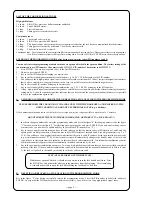
LIST OF THE VARIOUS SIGNAL TONES
High-pitched tones
1 x short:
EIN/ON key pressed or bolt mechanism unblocked.
2 x short:
End of blocked status.
1 x long:
Start coding mode.
2 x long:
Coding process completed correctly.
Low-pitched tones
1 x short:
The entered code is wrong.
2 x short:
EIN/ON key pressed while blocked.
1 x long:
This signal sounds after entering the correct numerical code after the lock has been manipulated (blocked status).
2 x long:
Coding process incorrectly performed. The old code remains valid.
3 x long:
The batteries have to be replaced.
Continuous tone: The electronic locks automatic fault detection routine has detected a defect. Please contact the service department,
even if the electronic system is still is perfect working order. Press the EIN/ON or ENTER key to silence the signal tone.
ENTERING THE PROGRAMMING MODE after keying in two master codes (PIN-numbers 1 and 2)
You can only enter the programming mode when the door is open and blocked in the open condition. The factory setting of the
two master codes are: PIN-number 1 has master code 11111111, PIN-number 2 has master code 22222222.
1.
Press EIN/ON. You are now expected to key in the first PIN-number.
2.
Do not so, press only ENTER.
3.
Key in the first PIN-number belonging to a master code.
4.
Key in the first eight-digit master number combination (e.g. 3 0 2 5 3 3 0 8) belonging to the PIN-number.
5.
You will hear a short, high-pitched signal tone if you have entered the correct number. A short, low-pitched signal tone indicates
that you have entered the wrong combination (in this case it is possible to enter the combination again twice).
6.
Key in the second PIN-number belonging to a master code.
7.
Key in the second eight-digit master number combination (e.g. 2 5 3 3 0 8 2 9) belonging to the PIN-number.
8.
A long, high-pitched signal tone indicates that you have entered the correct number and that the system is entering the number
coding mode. A short, low-pitched signal tone indicates that you have entered the wrong combination (in this case it is possible
to key in the combination again twice).
A.
CHANGING A NUMBER COMBINATION OR DELETING A PIN-LOCATION IN THE PROGRAMMING MODE
PLEASE PERFORM THE CHANGING OF THE CODE ONLY WITH THE DOOR OPEN AND BLOCKED IN THE
OPEN CONDITION AND DO NOT USE PERSONAL DATES (e.g. a birthday).
If the number combination used to set the lock is lost or forgotten, it is no longer possible to open the safe. Therefore:
DO NOT FORGET THE NEW NUMBER COMBINATION OR STORE IT IN A SAFE PLACE!!!!
1. In order to change a number code, enter the programming mode, and key in the figure 0 for changing a master code, the figure
"1" for a new usercode or the figure 3 for selecting a new opening code, and press ENTER. If you only want to change a user
or master code, you now have to additionally key in the relevant PIN- number (e.g. 5).
2. Key in the new number combination you have selected (please note that the master codes, at PIN-locations 1 and 2, and the
opening code are 8-digit numbers, whereas the user codes at PIN-locations 3 through 9 and 0 are 6-digit numbers) (e.g. 2 4 7
3 5 8). You will hear a short, high-pitched tone to indicate that the entry is valid. If you have keyed in an invalid new user code
(e.g. a trivial number such as 1 2 3 4 5 6) the electronic system will automatically change to the standby mode of the lock, and
you will have to start again from the beginning. In this case the old code remains valid. Trivial number combinations consist
of distinctive number sequences that are automatically identified and refused by the lock.
3. Key in the new number combination once more. Two long, high-pitched tones indicate that you have successfully completed
recoding of the lock. If the new number combination you keyed in does not match the new combination keyed in before (s. item
2), the lock will go back to the standby mode and the old code will remain valid.
TEST - PLEASE CARRY OUT WITHOUT FAIL !
With the door open and blocked, it should not be possible to turn the lock handle a half turn. Press
the EIN/ON key, and perform the whole opening procedure from the beginning. After completing
it, it should be possible to open the lock after turning the lock handle a half turn.
B.
DELETING OR BLOCKING A PIN-LOCATION IN THE PROGRAMMING MODE
Key in the figure 2 after having successfully entered the programming mode. Select the PIN-number to be deleted, and press
ENTER. As a sign that the PIN-number has been deleted successfully, you will hear two long, high-pitched signal tones.
-- page 2 --




















